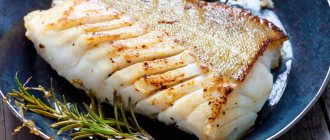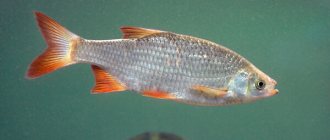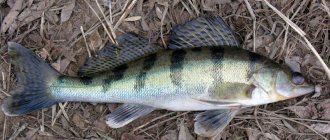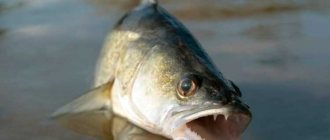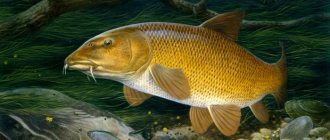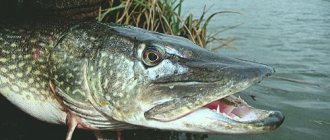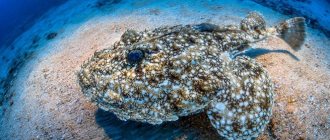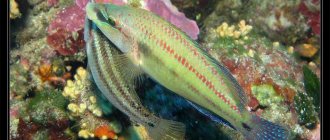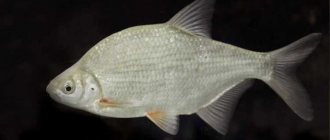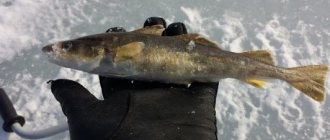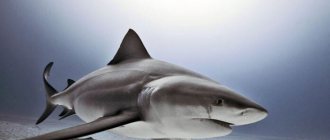How to distinguish ide from chub
4 minutes Author: Konstantin Pavlov 0
Ide belongs to the carp family, just like the chub and asp. Therefore, these types of fish are very similar to each other, which is why they are quite easy to confuse. Often passions flare up on fishing forums in discussions about what kind of fish this or that person caught, because they are so easy to confuse. However, there are still differences between ide, chub and asp, and if you study them well, you can understand at first glance what kind of fish is in front of you.
Distinctive features of ide
Ide is a rather interesting representative of the carp family. It lives in fresh water, but is capable of living in sea bays. This fish is extremely resistant to sudden changes in temperature. The most popular habitat is a deep muddy river or reservoirs or lakes, but always deep ones.
The body length of an adult fish reaches 35–50 centimeters, the average weight is about 3 kilograms. Sometimes you may be lucky enough to meet a particularly large representative with a length of about 90 centimeters; such a fish can weigh up to 8 kilograms. The main distinguishing features of the ide are a thick, short body, large greenish-yellow eyes, and medium-sized greyish scales. In spring, it changes its color to a more beautiful one; in the sun, the fish seems to shimmer with either silver or golden shades.
How to distinguish ide from chub
Two species such as ide and chub are very similar, especially if they are small fish. But it’s quite easy to distinguish adult individuals from each other, especially if you hold representatives of both species in your hands, or if you look at them in a photo.
Let's look specifically at how these two types of fish differ from each other:
- Body length. The difference between ide and chub is that the latter is noticeably longer. The average length of the latter reaches 50–80 centimeters.
- Body structure. The body of chubs is not so thick, the head is wider, as is the mouth, and the scales are large, while the ides have much smaller ones. In addition, the chub has a blunter head due to its wide forehead, which is how it actually got its name. His brother has a slightly pointed head shape.
- Color. These fish also differ in the color of their back. The chub has a dark green back, while the ide has a lighter back. There is also a difference between the fins. If in the ide they are slightly reddish, then in its relative they are bright red, sometimes orange.
- Habitat. It is worth considering the fact that chubs do not live in reservoirs with stagnant water, so you definitely won’t be able to catch them there. Unlike their comrades, they do not like depth and are more often found in the shallows; they love places with overhanging bushes.
Appearance and features
How to marinate fish
It was never possible to catch such large specimens close to the record (2.58 kg). However, fish of 500 - 700 grams periodically make themselves felt. Especially when it comes to reservoir fishing. The usual size of a soroga does not exceed 18 - 22 cm and a weight of up to 250 grams.
The roach is easily distinguished from other representatives of the large carp family by the irises of its eyes. They are orange-golden with a noticeable red spot at the top.
The oblong body is slightly compressed laterally. Covered with large scales. The belly and sides are light, with a silvery tint. The color of the back varies from greenish to dark brown. An almost straight line can be drawn between the beginning of the dorsal and ventral fins.
The gray dorsal and caudal fins contrast with the reddish ventral and anal fins. The body color of the track can change depending on the habitat and age-related changes.
Sexual maturation of roach varies depending on habitat. On average it is 3 - 4 years. In the northern regions of Eastern Siberia, the sorog begins to spawn at 5-6 years of age.
Roaches begin to spawn from the end of May until June. Its course directly depends on weather conditions. The roach chooses spawning sites in channels and oxbow lakes. In lakes that have connections with streams and outlets to large river waters. In reservoirs, roach spawn near the shore on last year's flooded vegetation.
Before spawning, males “dress” in nuptial plumage. The body becomes more contrasting. The fins are bright. The head and area of the body along the lateral line are covered with a “pearl” rash. It can be easily felt with your fingers. The female looks more modest. The brightness of the color appears less, and the “pearly” rash appears rarely.
Spawning occurs at the same time for the entire group living in the reservoir. Sticky eggs are swept onto plant debris at a depth of up to 1 meter.
At the end of spawning, the fish rolls down from shallow water to depth. The larvae and fry linger for some time at the spawning site. Here, in sun-warmed areas with shallow water and vegetation, there is plenty of shelter and food. At the end of summer, juveniles follow the adult fish to the deep open areas of the reservoir.
We invite you to read: Pike-perch fish - for anglers and those curious about predatory fish
Habitats
The roach avoids places with very cold, fast water. As well as areas with a muddy bottom. Prefers areas with slow, calm currents. However, in closed lakes the lack of natural water flow does not bother the sorog. However, everywhere it prefers a sandy-muddy or rocky bottom with shallow waters and deep places. It can often be found among thickets of aquatic vegetation near the coastline, driftwood, and flooded snags.
Roach is a fish prone to sedentary life. It does not make long migrations across the reservoir. Closer to autumn, it gathers in large flocks and strives to go deeper. Here she lives until spring. However, with changes in weather (thaw), it periodically enters shallow waters.
Roach is a typical representative of the carp family. Its value lies in both its excellent taste and the benefits that the beneficial components of the fish bring to the human body.
What does it look like?
The appearance of the roach is memorable: the fish has an oval oblong body, which increases with age, becoming wider and thicker. The entire surface of the body is covered with scales. On the dorsal side they are black, with a bluish and greenish tint. The scales on the sides and abdomen have a silvery-white tint.
In total, roach has 5 types of fins:
- dorsal;
- tail;
- abdominal;
- anal;
- chest
Dimensions and weight
Unambiguously answer the question: “Is roach a river or sea fish?” - it is forbidden. This is because it lives in rivers, lakes, ponds, and some seas
For the latter, there is an important rule: it can only be found in low-salt waters, for example, in the Azov, Caspian or Black Sea
Features of asp
Asp is the largest representative of the carp family. Its second name is sheresper. Its body reaches 80 centimeters in length; this fish weighs on average 10–12 kilograms. The eyes of the Sheresper are always bright, pure yellow with a small green stripe.
An interesting feature of the asp is its way of life. Unlike its two brothers, this is a daytime fish. This means that he sleeps at night and you definitely won’t catch him during night fishing. These fish go hunting exclusively during the day. The most distinctive feature of the asp is its anatomical feature - a blunt rib that is located on the belly between the fins.
The difference between asp and ide and chub
- Scales. The first noticeable difference between these fish is the color of their scales. In the asp it is dark and has a bluish tint, but in the chub it is golden-green. There is also a difference in its size. The sheresper has small scales, the ide has slightly larger scales, and the chub has the largest scales.
- You can also notice the difference between the fins, namely the anus. In an asp, this part of the body is quite wide, while the chub’s fin is narrower and slightly convex. There is also a difference between the color of the fins, since if you compare them in these three species of fish, it turns out that the sheresper has the lightest, slightly reddish, as well as a gray, slightly bluish tail.
- The eyes distinguish ide from asp. The latter ones are small. These three fish also differ in their jaws. Sheresper has a prominent lower jaw, but the other two species of fish have jaws of the same size.
What conclusion can be drawn? Of the three species of fish of the same carp family considered, ide is the smallest and widest fish. The next largest chub, its distinguishing feature is its wide forehead. And the asp, in turn, is distinguished by jaws that are not the same size. Therefore, knowing these features, it is quite easy to distinguish ide, chub and asp from each other.
Differences between asp and ide and chub
To distinguish a chub from an asp (sheresper), you need to pay attention to the following signs:
- the scales of the sheresper are much smaller in size than those of the lobati, they are also darker, and in medium and large specimens they have a bluish tint;
- the red fins of the asp are not as bright as those of the chub;
- the sheresper's eyes are smaller;
- Another characteristic feature of the asp is its strongly protruding lower jaw.
This photo shows the differences between asp, chub and ide:
It is also quite easy to distinguish a sheresper from an ide: the scales of the latter are larger and lighter, the red fins are brighter, the lower jaw is equal in length to the upper.
Unlike chub and ide, the asp is 100% a predator. It is not caught on float rods and donks. It can be caught by spinning, fly fishing or trolling. The only exceptions are very small asps, which can be caught on float rods and donkeys as bycatch.
Thus, the chub is noticeably different both in appearance and in behavior from its closest “relatives” - ide, roach, rudd and asp. To determine which fish was hooked, you must first pay attention to the shape of the body, head and jaws, the color of the trophy and its scales. If you have a trained eye, it will not be difficult to distinguish different representatives of the carp family.
Ide fish, its difference from the chub and where it lives
Ide, like asp, belongs to the carp family, representing one of the most interesting species of the ray-finned family.
This representative of cyprinids is a freshwater species, but can also tolerate slightly salty water of sea bays. The main places where this fish lives are rivers, river ponds and flowing lakes. But you won’t find it in mountain rivers with fast and powerful currents or in cold reservoirs. The ide fish is one of the hardiest river inhabitants and can easily tolerate temperature changes, including sudden ones. At the same time, the most comfortable body of water for it is a clean, deep river with a moderate current and a silted clay bottom. It can also live in reservoirs, preferring deep places, avoiding rocky and sandy areas.
The lifespan in natural conditions ranges from 15 to 20 years. But as a rule, an ide rarely manages to live to see its 10th birthday.
Where does ide live?
In Eurasia, ide is a widespread fish. Inhabits the basins of almost all large rivers of Central and Eastern Europe, Siberia and parts of the Far East.
In some states, ide was introduced. For example, to the UK, France, USA.
However, seeing such a large range, one should not assume that ide lives everywhere. In the bed of one river, in some area, fish may be completely absent, but in another, they may be ordinary.
In addition to bodies of water with currents, it does well in standing bodies of water. In general, ide is a plastic fish. She doesn’t need particularly ideal living conditions. Can live in muddy, partially polluted waters. Moreover, both in fresh water and in water with some salinity (up to 10 grams per liter). For this reason, ide is found in desalinated areas of the seas. These are the Baltic, Black and Caspian seas, the mouth of the Ob in the Kara Sea. However, despite the possibility of living in low-salinity waters, the question “is it a river or sea fish?” we can say with confidence that it is river. Since all the main life cycles of fish are related to fresh water.
In rivers it prefers deep reaches and places full of holes. Doesn’t go out into open rapids, loves areas with moderate currents. It stays in bays and backwaters bordering the current. It comes to the rifts seasonally, to feed, when juvenile fish hatch.
There is information that supposedly ide avoids cold waters. However, if we judge where the ide lives and when it spawns, it is clearly clear that everything is far from the case.
Appearance
Let's figure out what ide looks like? The length of the thick body of an adult fish varies from 35 to 50 cm, and especially large individuals can reach a length of 90 cm. At the same time, the average weight is up to 3 kg , but there are also record holders, ides up to 8 kg! Moreover, representatives of the species in central Russia weigh about 1.5-2 kg. But in clean and oxygen-rich artificial reservoirs, the fish reaches very impressive sizes.
You can recognize a fish by the following signs:
- Thick body.
- Shortened head.
- Small slanted mouth.
- Large eyes.
- Usually gray in color
The body color of the ide may vary depending on the time of year or the age of the individual.
Adult individuals have a gray, metallic body color with golden “cheeks” and head. At the same time, in the sun, the color can change , becoming either completely dark or silvery-golden. The sides are close in color to white, creamy yellow, the back is black with a blue tint. The reddish-crimson color is characteristic of the lower fin, less often – the caudal and upper fin. Some fish have a much darker dorsal and caudal fin - silver-gray with a purple tint. The scales are medium in size.
The color of the eyes is yellow or yellow with a tint of green, the shell of the eyes is a characteristic bright orange color.
Young individuals , which are usually called roaches, are distinguished by a lighter body color, silver, and their fins are much paler. The older the fish gets, the more contrasting color its body acquires.
Let's figure out how to distinguish the ide fish from the chub, which is similar in appearance. The chub is a freshwater representative of the carp family, with a flattened massive head and large scales. The following signs will help you distinguish ide from chub:
- Lighter color on the back.
- Narrower head. In the ide it is slightly pointed, in the chub it is more blunt.
- The scales are smaller in size.
- The mouth is narrow.
- The chub has a larger mouth.
- The body of the ide is somewhat flattened on the sides, which is not the case with the chub.
Also, the ide fish, the description of which is presented above, has several similar characteristics with the roach, but differs from the latter in its lighter back, yellow eyes and scales - they are smaller in the ide.
There are a number of differences between chub and asp that will help the fisherman avoid making an annoying mistake:
- The asp has a lighter silver-gray color.
- The anal fin of the asp is wide, while that of the chub is convex and narrow.
- A prominent lower jaw characterizes the asp, while in the chub both jaws are identical.
Knowing these signs will allow you to correctly identify the caught fish.
Appearance and differences of ide.
Ide is a very beautiful fish. Its beauty is fully manifested in spring - during the spawning period. The steel scales on Ya.'s muscular body shimmer with gold, especially on the head and gill covers. As soon as you turn the ide a little, it turns from a silver beauty into a goldfish, and with the next movement it can acquire a dark bronze color.
The lower fins of the fish glow with a red crimson, sometimes flowing onto the dorsal and tail plumage, the gray color of which usually does not shine with beauty. The contrasting colors of the dark blue back and snow-white belly give the ide's appearance a special attractiveness.
During the mating season, the head and body of males are covered with small white grains, which disappear after spawning. Their number emphasizes the productivity of the producers, and during this period they themselves serve as a distinguishing feature of males from females.
The ide is very similar to the chub and roach; roaches are especially similar - small individuals that have not reached 0.6-0.8 kg in weight.
A tall body, small scales, a short head, a convex and wide forehead, but not as huge as that of a chub, a yellowish-green iris of the eyes, a small and oblique terminal mouth - these are the features that distinguish the ide from its “opponents”.
Habitat area
It has a wide distribution area:
- Most countries in Europe (except the south and southeast).
- The Arctic Ocean basin (from the White Sea rivers to the Lena).
- Bays of the Baltic Sea.
- Basin of the Aral Sea.
- The main territory of Siberia.
- Black Sea basin.
- Northern section of the Caspian basin (Volga and Ural rivers).
- North America (Connecticut in the USA).
Ide is very widespread in Ukrainian reservoirs , where it is found in almost all lakes, reservoirs and rivers.
Habits
The fish is a cautious fish, preferring to live in schools, often large ones. But large individuals prefer to live alone. Young roaches choose coastal zones to live , while adults prefer to live in the depths. The ide fish spends the winter at depth, hibernating together with the perch. Under the ice in spring, fish gather in schools and begin to approach the shores. When the river opens up, the flocks rise upstream, staying near the banks, without leaving the riverbed into the floodplain, except in floodplain lakes connected by channels with the river.
The spawn starts early. The eggs located in the riverbed do not die during the decline of spring waters. Having spawned, the fish go to the depths, after which, after several days, they visit the sandbanks to feed.
Bait for rudd
Most people going fishing are concerned about two main problems: what to use to catch rudd and why fishing is successful? When the first frosts appear, the fish gather in schools and tend to stick to the bottom. If you don’t cast the bait into the depths at this time, the fish simply won’t see it.
Photo 3. Worm is an excellent bait.
In order for fishing to produce results, you need to use bait, focusing mainly on the type of reservoir. It is best to fish using insects and their larvae. It makes sense to note that in warm regions the best effect is provided by plant-based foods. In cold regions, it is preferable to use insect larvae.
Advice. Rudd disdains earthworms if they are hooked as a whole, but greedily pecks at their individual parts. You simply need to put a piece of worm on the hook, and a successful catch is guaranteed.
Another excellent bait are snails and caddis flies, which can be collected on the banks of the river.
Nutrition
Ide is not a gourmet; his diet is quite varied and may include elements of plant and animal foods:
- worms;
- shellfish;
- insects;
- larvae of stoneflies, caddisflies, chironomids;
- juveniles of other fish.
That is why fish are classified as euryphages , that is, omnivores. But the diet of ides varies by season: in the spring it consists mainly of animal food, and in the summer and autumn - of plant food. The ide begins to feed heavily after spawning. The ide is not picky about food, consuming the food that can be found in the reservoir.
PHARYNGEAL TEETH.
The presence of pharyngeal teeth is a characteristic feature of carp fish, which in the process of evolution completely lost their normal teeth, that is, those located on the jaws. The pharyngeal teeth, of course, lie in the pharynx and perform the function of the lower jaw. The role of the upper jaw is played by a special bone outgrowth located in the roof of the pharynx - a “millstone”. The pharyngeal teeth move back and forth and up and down and grind and grind food against a millstone. It is most convenient to study pharyngeal teeth directly in the process of eating the fish being studied - they are perfectly preserved during boiling, frying and other cooking methods. You need to pay attention to the number and shape of the teeth and how they are located on the “pharyngeal jaw” - in one, two or three rows.
Now that we have comprehended these ichthyological wisdom, we can proceed directly to the definition of fish.
| Dace | Chub | Ide | Roach | |
| Number of scales in the lateral line | 48-52 | 43-47 | 56-61 | 41-48 |
| Mouth position | The mouth is small, the apex is at the level of the lower edge of the eye | The mouth is large, the apex is at the level of the middle of the eye. | Slightly different from dace | The top of the mouth is higher than the bottom edge of the eye |
| Tail fin | long, with deep recess | relatively much shorter and less notched | Slightly different from dace | Slightly different from dace |
| Pharyngeal teeth | In two rows, 5+2 or 5+3 | In two rows, 5+2 | In two rows, 5+3 | In one row, 5-6 teeth |
| Anal fin | Sinuate | Rounded | Sinuate | Sinuate |
What does the table above give us? It shows that the dace is reliably different from the chub in all of the listed characteristics, except for the number and location of the pharyngeal teeth. It is more difficult to distinguish dace from ide, especially when it comes to the redfin form. The only reliable sign is the number of scales in the lateral line. Finally, the only feature that is guaranteed to distinguish dace from roach is the “row” of the pharyngeal teeth. Roaches have single-row pharyngeal teeth.
And in conclusion, a few words about bleak. I think that Maxim Blokhov’s doubts about the possibility of distinguishing dace from bleak are caused by the fact that he simply did not see the bleak - after all, it does not live in the Yenisei and, in general, in Siberia. Bleak belongs to a separate genus (Alburnus)
, the species of which differ from dace in many ways. It seems to me that it is quite difficult to confuse bleak and dace - outwardly they are quite clearly different. In addition, the bleak is distinguished from dace and from many other fish (but not all) by the presence of a leathery, pointed keel located behind the ventral fins.
Reproduction
The ide fish becomes ready for reproduction at the age of five , with a body length of up to 30 cm and body weight of 600 grams.
Spawning of ides is early, occurring at the end of May - beginning of June, the water temperature does not exceed 6 °C. Spawning most often occurs in the evening, much less often in the morning, eggs are laid in one go. During the life of an individual, spawning occurs several times; the number of eggs from one spawning depends on the size and age of the ide and can reach more than one hundred and thirty thousand. The duration of spawning in favorable weather is no more than three days; in deteriorating weather conditions it can take up to 10 days. If the weather changes sharply, then reproduction may be delayed until the thaw. Eggs are deposited on branches and vegetation that have been in the water since the previous year, on stones and woody debris.
The color of the caviar of this large fish is yellowish, the size is small, about the size of a small grain, and is not much different from the caviar of other fish.
Embryos develop within 15-30 days; for best development, the water temperature should be around 10°C. The larvae appear in the second week of June, weigh up to 2 mg and body size up to 8 mm.
Fishing for ide begins in small reservoirs in early spring after the melt water has subsided until it clears. Fishing is also possible in winter during thaw periods.
About useful and culinary properties
Ide is a very nutritious and tasty fish , however, due to its high calorie content, caution should be exercised when consuming it, especially for people with weight problems. Nutritional value is:
- Calorie content (fresh ide) - 116 kcal.
- Calorie content (boiled ide) - 88 kcal.
- Proteins – 19 g per 100 g of fish.
- Fats – 4.5 g.
- Carbohydrates – 75 gr.
Protein contains amino acids essential for human health: taurine, lysine, tryptophan.
Ide meat is a real
storehouse of microelements useful for the human body: it also contains phosphorus, calcium, magnesium, potassium, iron, chromium, molybdenum, sodium.
Dishes made from this fish are perfectly absorbed by the body. Due to the high content of phosphorus and calcium, ide can be an excellent means of preventing osteoporosis and other diseases of bones and teeth. Ide is a very beautiful and useful fish, catching which is a blessing for any fisherman. It has a wide distribution area and important commercial value, which is why the fish often becomes an object of fishing at the amateur level.
